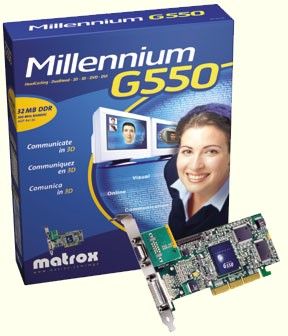Matrox Launches The G550
Introduction

The last time we covered a Matrox product was this review of the G450 . Looking at the G550, there's a little bit of a sense of deja vu, or is it history at work. Here's a bit more history that might interest you: for its fiscal 1997 results, Matrox announced sales of $690 million. Prior to this announcement, Matrox had reported $30 million in 1993, $75 million in 1994, $210 million in 1995 and sales for fiscal 1996 were said to surpass $500 million - a growth rate of over 200% each year.
The company didn't go public, and remains privately held to this day so, it's even more startling to think that at one point Matrox seemed to be sitting on top of the heap and destined for more. No outside investors, no $200 million check from Microsoft, no stock market to back it up. However, Matrox' management didn't capitalize on the opportunities they had, or even take the money and run in an IPO. Boy, is Matrox an enigma, or what.
So, to this day I think of Matrox as the plucky outsider, although I also think of it as an anachronism in a graphics market that is dominated by 3D benchmarks, sex appeal, and big is better philosophies. Into the 3D melee, Matrox launches its latest graphics chipset, the Millennium G550. You'll probably never see a G550 on anything but a Matrox board, and the product's most interesting features are part and parcel of a board and bundled software package so, it isn't fair to judge the G550 as a standalone chipset. However, the G550 is pin compatible with the G450, and the biggest changes to the Matrox product line are going to come in the minor improvements the G550 delivers over its predecessor. This is a preview of what to expect when Matrox starts shipping G550 boards in earnest in August.
Stay on the Cutting Edge
Join the experts who read Tom's Hardware for the inside track on enthusiast PC tech news — and have for over 25 years. We'll send breaking news and in-depth reviews of CPUs, GPUs, AI, maker hardware and more straight to your inbox.
Most Popular

